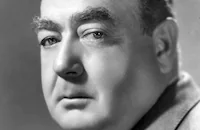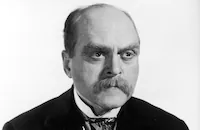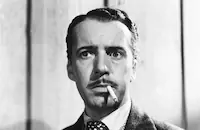One Exciting Adventure
Cast & Crew
Ernst L. Frank
Binnie Barnes
Neil Hamilton
Paul Cavanagh
Eugene Pallette
Grant Mitchell
Film Details
Technical Specs

Synopsis
Singer Rina Sorel goes about Europe stealing diamonds on impulse because she loves the way they glitter. In Paris, when she steals a diamond from a jewelry store, a strange man pays for the diamond after the jeweller has called the police. Inspector Kleinsilber and his assistant, Fussli, whom Kleinsilber thinks is incompetent, arrive on the scene and retrieve Rina's glove, which matches a string of gloves left by Rina all over Europe each time she stole a valuable gem. Fussli takes the glove to his neighbor Walter Stone's perfume counter, where Walter determines the thief's scent, a bottle of which was delivered recently to the Hotel Atlantic, room 88. Fussli and Kleinsilber search Rina's room moments after she has hung her new diamond on the chandelier. The strange man then introduces himself to Rina as Lavassor and confesses he has been following her all over Europe, but she rebuffs him. Walter helps Rina escape from the hotel to a train so she can cross the border, but that night he finds her in his apartment and lets her stay. When Rina explains that all the diamonds she has ever stolen are in her hotel room, Walter agrees to help her return them if she promises to go straight. While Kleinsilber continues to search Rina's room with no luck, Walter and Rina, posing as an electrician and a maid, turn the lights out on him. Lavassor then enters as "Krumbiegel," the hotel's chief engineer, and retrieves the diamond from the chandelier, but when Rina steals it back from him, he explains that her diamonds are all his because he has paid for them. Lavassor tries to blackmail Rina into becoming his partner in crime by telling her she will never cure herself from her compulsion to steal and that if she steals again, Walter must disappear. Rina vows to reform in order to save herself for Walter, and the two swear their love. Walter and Rina then visit Fussli, who is calculating how much reward money he will receive for the capture of the great crooks of Europe. Among them is international jewel thief and forger Jean Continescue, who stole The Star of Araby, a priceless diamond. Walter pockets the thief's photo, and he and Rina attend a show at the Palace Casino. Lavassor, who owns the casino, plants a woman wearing diamond earrings in the audience to tempt Rina, but she resists. When Walter sees Lavassor in the audience, he realizes he is Continescue and retrieves Fussli, who is drunk. In Walter's absence, Lavassor shows Rina The Star of Araby, and she nearly steals it. Kleinsilber raids the casino as Fussli and Walter arrive and handcuff Lavassor. As Kleinsilber is about to arrest Rina and Walter as Lavassor's accomplices, Fussli clears them and assures Kleinsilber he will be made the new police inspector.

Director
Ernst L. Frank
Cast

Binnie Barnes

Neil Hamilton

Paul Cavanagh

Eugene Pallette

Grant Mitchell
Ferdinand Gottschalk

Edward Keane

Henry Kolker

Doris Lloyd
Dorothy Christy

Edward Mcwade

Boyd Irwin
Captain E. H. Calvert
Edna Searle
William Gould
Alice Ardell
Dick Winslow
William Worthington
G. P. Huntley Jr.

Phyllis Brooks

Ann Doran

Joan Woodbury
Lyman Williams

Carl Miller

Bess Flowers
Arnold Gray
Crew
Norbert Brodine
Milton Carruth
Stanley Fleischer
Ernst L. Frank
Ernst L. Frank
Henry Henigson
William Hurlbut
William B. Jutte
Gilbert Kurland
Carl Laemmle
Carl Laemmle
M. F. Murphy
Victor Noerdlinger
Samuel Ornitz
Maurice Pivar
Jean Raymond
W. J. Reiter
Murray Seldeen
Harry Tobias

Film Details
Technical Specs

Quotes
Trivia
Notes
Although the film was not viewed, the above plot and credits were taken from a studio cutting continuity and dialogue script. The working title for this film were What Ladies Dream and Escapade. The German script on which this film was based was originally filmed by Superfilm-Haymann by director Geza von Bolvary, and was released in Germany on April 20, 1933. The Daily Variety preview length for this film was 90 minutes. Copyright records list Ernst L. Frank as associate producer, while the Motion Picture Herald review lists Henry Henigson. The Universal production files at the USC Cinema-Television Library list "Ernst Laemmle" as director, although this is probably an erroneous reference to Ernst Frank. The files also credit Milton Carruth as director, although no evidence that he directed scenes in the final film has been found. According to the production files, an exterior street scene was shot on the Paramount lot. Variety states that the kitchen set used in this film has shown in several Universal pictures. The reviewer also opines that film "customers are seldom interested in women crooks." According to the Universal production files at the USC Cinema-Television Library, Harry Tobias wrote American lyrics for this film's songs. Although only one title, "The Road to You," was found, it is possible that the film contained more than one song. The composer of "The Road to You" is unknown.












